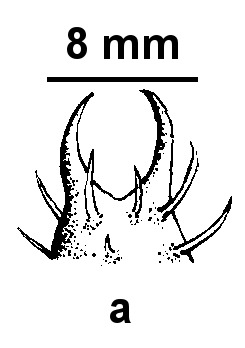Xanthium orientale
L. Californian BurrErect, usually branched annual herb to 2 m high; stems scabrous, unarmed, green or purplish. Leaves broad-ovate to triangular in outline, mostly 4–15 cm long and wide, 3- or 5-lobed, surfaces green and scabrous, lobe apices rounded to acute, base cordate, margins coarsely and irregularly toothed; petiole to c. 12 cm long. Male capitula 0–7, 5–8 mm diam.; involucral bracts ovate, 1–3 mm long; florets c. as long as involucre, pubescent. Female capitula 1–15 in axils below males; fruiting involucre ellipsoid, 4–7 mm diam., 1.5–2.5 cm long, pubescent with mixed glandular and eglandular hairs; hooked spines 3–5 mm long, pubescent in lower half, brown to purplish; beaks broad-based, 4–6 mm long, divergent, incurved and hooked. Cypselas 1–1.5 cm long. Flowers Dec.–Mar.
MuM, VRiv, MSB, RobP, NIS, EGU. Also naturalized SA, Qld, NSW. Native to North America. Scattered across drier parts of northern Victoria. A weed mainly of pastures and irrigated land.
Apparently much less common in Victoria than the very similar X. occidentale.
Xanthium occidentale, X. cavanillesii Schouw, X. orientale L. and X. italicum Moretti (all naturalised in Australia) are often treated as an aggregate species X. strumarium L. Species in this complex may produce seed asexually and hybrids may occur between species, adding to the inherent taxonomic difficulties of this complex.
Jeanes, J.A. (1999). Asteraceae. In: Walsh, N.G.; Entwisle, T.J., Flora of Victoria Vol. 4, Cornaceae to Asteraceae, pp. 652–666. Inkata Press, Melbourne.
 Spinning
Spinning

